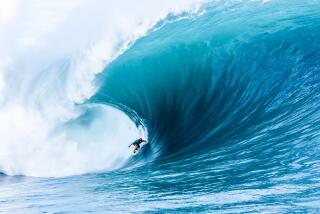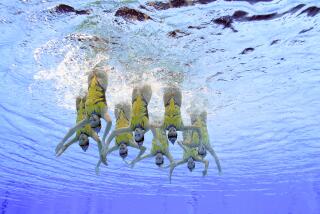Surfing whodunit
- Share via
AT 77, Bob Meistrell leads deep-sea diving expeditions to Catalina Island and remains at the helm of Body Glove International, the multimillion-dollar Redondo Beach surf company he co-founded with his twin brother Bill half a century ago.
Jack O’Neill, 82, is a bit landlocked these days after turns as a wartime pilot, surfing legend and driving force behind Santa Cruz-based O’Neill Inc., one of the surf industry’s most recognized brands.
Age forced Hugh Bradner, an 89-year-old UC Berkeley physics professor and Manhattan Project scientist, to mothball his scuba tanks a few years ago and downshift to a quiet and modest life in La Jolla.
These three Californians share more than Social Security checks. Each claims to be the father of the neoprene wetsuit, an invention that debuted in the early 1950s and revolutionized surfing and deep-sea diving.
“That’s got to be the longest-standing argument in surfing,” says Matt Warshaw, a San Francisco-based surf historian.
Argument hardly covers it. Mystery is more like it, a whodunit built on 50 years of boasting and recalling the successes of men who are all vying for the same crown. Each declares he’s the sole inventor, dismissing the others as mere marketers.
“We developed the surf suit. I just know we did it,” O’Neill says from his oceanfront home in Santa Cruz.
Meistrell, in constant motion inside the dining cabin of the company’s 72-foot yacht, is similarly certain and direct. “I believe we did it first. And everyone copied us,” he says.
O’Neill and Meistrell have locked horns in the wetsuit business and threatened lawsuits for decades. Each revels in his insistence that the other is wrong.
Bradner, the lone non-multimillionaire of the bunch, stakes his claim with professorial precision.
“The only invention I claim in this is the neoprene wetsuit,” he says. “If somebody has documentation that precedes mine, I’d like to hear about it.”
*
Oiled sweaters
EARLY surfers and divers routinely immersed themselves in 45-degree seas with nothing more than a swimsuit, oil-soaked wool sweaters or long underwear.
“We’d dive to 200-foot depths without wetsuits,” says Jim Stewart, the former head of the underwater program at Scripps Institution of Oceanography in La Jolla. O’Neill and others experimented for a time with vests made from polyvinylchloride, or PVC. Though the vests offered some protection, they absorbed water, making them more like lead suits than wetsuits.
Then came the real thing. As the name suggests, wetsuits aren’t waterproof. They work by providing an insulating layer between skin and outside air and water. Neoprene, which emerged from World War II military research on various rubbers and plastics, remains the essential material -- lightweight, flexible, comfortable and durable -- that most effectively keeps surfers and divers toasty even in 40-degree water.
Walk along any California beach on a winter morning and you’ll see as many wetsuits as there are surfers. Ditto for divers. To this day, early surfers tend to credit O’Neill and occasionally the Meistrells; divers tend to pick the Meistrells and, once in a while, Bradner. For Body Glove and especially O’Neill Inc., the claim is an important piece of corporate lore. Each company traces its roots to the early 1950s surf and dive shop that became a mega-business with wetsuits as its core product -- and founders as inventors are a key part of its image.
The O’Neill website seamlessly connects Jack O’Neill’s rambunctious and colorful personality by backing up his tale of being the inventor of the wetsuit and discovering neoprene in a eureka moment.
“If you were one of Jack O’Neill’s children, founder of O’Neill Inc. and wetsuit inventor,” reads a passage on the O’Neill company website, “you might very well listen as he told ice-cold horror stories that drove him to develop our trusty neoprene armor.”
The O’Neill site displays grainy photos to reinforce the impression of its patriarch as a cross between Capt. Nemo and Thomas Edison. Then the website continues with an even more startling revelation.
“Jack finally struck gold with neoprene, which he discovered carpeting the aisle of a DC-3 passenger plane.” But that’s unlikely, according to Frank Thompson, curator of the Prairie Aviation Museum in Bloomington, Ill., who says rubber was not used for carpeting, carpet lining or padding on a DC-3 or almost any passenger airplane for a simple reason: It’s not fire retardant.
Body Glove takes a less direct -- but no less sweeping -- approach to its claim.
“Like modern-day Einsteins for the ocean, the twins used their creativity and found a new insulating material called neoprene and invented the first practical wetsuit,” its website says. Meistrell readily admits that his discovery of neoprene has as much to do with Bev Morgan as it does with him. Manhattan Beach native Morgan, 73 -- a member of the diving hall of fame, a surfing pioneer and dive gear inventor -- made wetsuits with the twins in the early days. It’s Morgan who gets the credit for inventing the wetsuit in Warshaw’s “Encyclopedia of Surfing.”
If O’Neill says he discovered neoprene on an airliner, how did the Meistrells and Morgan find out about it? It was from a report on wetsuits written in 1951 for the U.S. Navy and the National Research Council that was moldering on a library shelf at Scripps, according to Morgan.
At the time, Morgan was living the life of a beach bum, often driving south to La Jolla to surf. Between swells, he read about diving, hanging out at the Scripps library. “A librarian knew I was into diving and surfing and she gave me this report about wetsuits,” Morgan says.
So who wrote the report?
“Jack O’Neill didn’t invent the wetsuit, the Meistrells didn’t invent the wetsuit and I didn’t invent the wetsuit,” Morgan says plainly. “Hugh Bradner invented the wetsuit. [He] was the first to use neoprene, and came up with the whole concept.”
Carolyn Rainey, a research librarian at Scripps, backs Morgan’s version. She mustered correspondence, research papers and conducted interviews for a scholarly article published in 1998 by Scripps called “Wetsuit Pursuit: Hugh Bradner’s Development of the First Wetsuit.” According to Rainey, Bradner clearly was the sole inventor. “He doesn’t get the attention or notoriety he deserves,” she says. “What he did was amazing and hardly anybody knows it because he’s so modest.”
*
The first splash
AS a physicist, Bradner specialized in materials. Fresh from working on developing the atomic bomb under the auspices of the Manhattan Project during the war years, he worked with the Navy.
“I looked at underwater combat and began by figuring out what needed the most improvement,” Bradner says. “That was a wetsuit.”
To this day, the wetsuit’s basic concept is what Bradner came up with sometime in 1949: You don’t have to stay dry to stay warm. From that discovery, his knowledge of materials led him to neoprene rubber.
He constructed the first wetsuit in a UC Berkeley lab. It looked similar to today’s models but was bulky, heavy and stiff. Bradner took the first plunge in a neoprene wetsuit in the winter of 1950 at Lake Tahoe.
“I remember walking from shore and there was ice at the edge of the lake,” he says. “I had to break it to get in. I splashed around.”
Bradner founded a wetsuit-making company that he called Edco to cash in on his invention. Though he sold a handful of his early models to the Navy and others, no one expressed much interest. Bradner never patented his wetsuit design.
Edco went bust about the time the Meistrells started selling their Bradner-derived wetsuits out of Dive ‘N Surf.
“I got free wetsuits,” Bradner says. “But I found out I wasn’t much of a businessman. I didn’t think there was a good market for them.”
Bradner couldn’t have been more wrong. Today, O’Neill and Body Glove sell about half a billion dollars in goods a year, with wetsuits going for about $200 a pop.
When presented with Bradner’s evidence, Meistrell and O’Neill soften their stances.
“Well, he [Bradner] did invent it,” Meistrell says. “What we did was truly improve on it over the years.”
O’Neill doesn’t concede quite so much. “I’ve talked to Hugh and I told him what I had done and how I got started,” he says. “We didn’t conclude anything.”
But for Bradner, it really wasn’t about the money. “My concept is the basis for every subsequent design,” he says with pride.
And his design almost lifted him into the same company as John Glenn and his space capsule or the Wright Brothers and their plane.
Almost. A few years ago a curator for the Smithsonian Institution in Washington, D.C., called him, hoping to exhibit the original wetsuit.
“They were all gone by then,” Bradner says.
More to Read
Inside the business of entertainment
The Wide Shot brings you news, analysis and insights on everything from streaming wars to production — and what it all means for the future.
You may occasionally receive promotional content from the Los Angeles Times.










